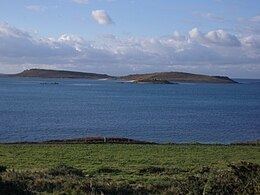Area 39 ha | OS grid reference SV877127 Population 0 Island group Isles of Scilly | |
 | ||
Similar Tresco - Isles of Scilly, Gugh, Round Island Light - Isle, Teän, Eastern Isles | ||
Samson (Cornish: Enys Samson) is the largest uninhabited island of the Isles of Scilly, off the southwestern tip of the Cornish peninsula of Great Britain. It is 38 hectares (0.15 sq mi) in size. The island consists of two hills, North Hill and South Hill, which are connected by an isthmus on which the former inhabitants built many of their sturdy stone cottages. Samson was named after Samson of Dol.
Contents
- Map of Samson United Kingdom
- HistoryEdit
- PopulationEdit
- Visiting the islandEdit
- Literary associationsEdit
- References
Map of Samson, United Kingdom
HistoryEdit
The twin hills of Samson were formerly associated with breasts, in a similar way to the Paps of Jura in Scotland and the Paps of Anu in Ireland. There are large ancient burial grounds both on the North Hill and South Hill.
The island was inhabited until 1855, when the Lord Proprietor Augustus Smith removed the remaining population from the island. By this point, the population was found to be suffering from severe deprivation—particularly due to a diet of limpets and potatoes—and consisted of only two families: the Woodcocks and the Webbers. Smith then built a deer park on the island, but the deer escaped from their stone walled enclosure, and some attempted to wade across to Tresco (at low tide). In August 1933 a major fire occurred which was put out by the staff of Major Dorrien-Smith, by digging ditches to stop the spread.
In recent times, the area has become a protected wildlife site. The island houses many different birds such as terns and gannets, and many wild flowers. In 1971 the island, along with the nearby islands of Green Island, Puffin Island, Stony Island, and White Island, was designated a Site of Special Scientific Interest (SSSI) for their biological characteristics.
PopulationEdit
Visiting the islandEdit
Boat trips to Samson are regularly available May through September. There is no quay, so visitors disembark via wooden plank. The remains of the old cottages can be explored, and there are also the remains of Smith's deer park and prehistoric entrance graves. There are no amenities or services available, but guided walks are led by local experts.
Literary associationsEdit
The island is featured in the children's story Why the Whales Came by Michael Morpurgo. In the book, Samson is under a curse that needs to be lifted. The island also featured in Armorel of Lyonesse by Walter Besant. Many have made reference to Webber's Cottage on Samson as Armorel's house.
The island also features in the Ann Bridge novel, The Dangerous Islands.
